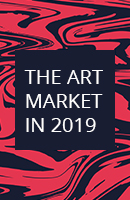Editorial by thierry Ehrmann, Artprice founder and CEO of ArtMarket.com: “The Art Market’s growth is based on confidence”
Each work of art is unique… but it is rarely seen in isolation; that’s what the top auction results in 2019 tell us. Claude Monet’s Meules (Haystacks) (1890) is from one of the most famous series of paintings ever created, with the other versions belonging to some of the world’s most prestigious museums. Likewise for Jeff Koons’ sculpture Rabbit (1986), which exists in three copies (plus an artist’s proof) and for Robert Rauschenberg’s Buffalo II (1964). The links between works sold on the secondary market and those shown in museums constitute a network that consolidates the acceptability and value of the works in both spheres.
As Duchamp rightly said: it is the viewer who makes the work. But the viewer necessarily makes links with what he/she has seen elsewhere. In this sense, the proliferation of museums, foundations and collections has a stabilising effect on the Art Market and particularly on the Contemporary Art segment. Twenty years ago, this weighed less than US$100 million. In 2019, it was worth nearly US$2 billion. And – like lots of other markets – the principal driver of this growth is quite simply confidence.
Although every work of art retains some level of mystery – an aspect we cannot understand or define – the viewer, whether an admirer, a collector or a professional, is necessarily looking for references to ‘place’ the work and/or to understand the logic behind its price. As we can see from our data, the artists currently eliciting the highest demand at auctions are those aged between 30 and 40 whose work has had time to mature, be exhibited, be collected… and be ‘recognised’.
Today the Art Market has reached an unprecedented level of maturity that allows it to override political instabilities, as we have seen this last year in both London and, to an even more surprising extent, in Hong Kong. China – which barely existed on the global Art Market in 2000 – now accounts for almost a third of its total value.
To present a truly global vision of the Art Market, our Report gives China credit for the dynamism and stimulation it contributes to the global market as a whole and it fully explores China’s role as the United States’ biggest rival. Yes… China’s Art Market has its own specific codes, but that just makes it all the more interesting. This is why our partnership with AMMA (Art Market Monitor by Artron) is both crucial and exciting.







 30.6
30.6
